Team Validates Quark-Hadron Duality Studying Interplay of Quarks, Gluons
Major New Installation Comes to Hall C
Training: New Self-Study Resources Offer Staff Scheduling Flexibility, Information
- Mark Your Calendar for Lab Luau, July 23
- New Lab Posters Available for Pickup
- Sign Up Now to Help with Open House
- Public Affairs Wants Your Story Ideas
- 15 Years of Dedicated Service
Richardson Unveils New Security Program
Team validates quark-hadron duality studying interplay of quarks, gluons
by James Schultz
It took effort, but a team led by Cynthia Keppel, a Jefferson Lab staff scientist and assistant professor of physics at Hampton University, begged and borrowed time over two years from individual spectrometers in Hall C. "We were scavengers," she says. "We collected data whenever we could."
The payoff for their persistence is the experimental validation of a phenomenon known as quark-hadron duality. The confirmation is an important step on the road to an intersection between certain nuclear physics theories and quantum chromodynamics (QCD), the theory which describes the ways quarks make up and interact with ordinary matter.
"The theorists are excited by this," Keppel says. "These data are telling us that some surprisingly simple physics governs complex particle states. Hopefully, one day, we'll be able to describe nuclear interactions completely in terms of the fundamental interplay between quarks and gluons."
Duality -- the idea that properties of reactions calculated at the quark level are retained at the level of the observed particles, the so-called hadrons -- appears to be an intrinsic property of sub-nuclear matter. Physicists know that when electrons scatter from intact hadrons, such as the single proton that makes up the hydrogen nucleus, the proton can just recoil as a whole.
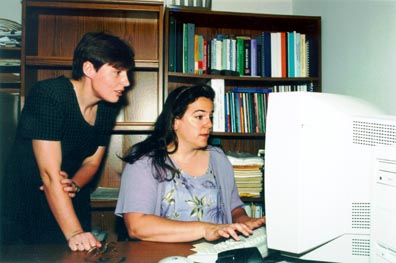 Ioana Niculescu (left) and Thia Keppel review inclusive resonance spectra from their quark-hadron duality test. |
However, the energy transferred from the electrons to the proton can also cause the proton to be excited into a higher energy state, a process known as resonance formation or to emit new particles (for example, pions). The JLab findings indicate that these various processes apparently yield the same result on average as expected from single quark scattering. This appears to confirm duality: the notion that the basic electron-quark interaction is the dominant process.
But the experimental results come with a "twist" " literally. QCD theory, as it explains the interactions of the quarks and the gluons that bind quarks together, allows for interactions between the struck quark in the electron-quark scattering process and the other quarks in the nucleon. Such interactions are termed higher twist effects, and are predicted to be large in the JLab energy regime. Yet, the new results indicate that such effects are surprisingly small, or perhaps cancel each other out. (See the diagram.)
Single Quark Scattering Dominates Interactions
"We observed minimal higher twist effects on the average. That's quite surprising," she says. "It implies that single quark scattering is the dominant effect, even in a multi-quark system such as a bound nucleon or nucleon resonance."
An additional surprising result was that the duality-averaged data at low momentum transfers (the momentum passed from the electron to the struck quark) are sensitive only to the quarks which contribute to the charge of the nucleon. Because there is a substantial amount of energy available, there also exists a sea of additional quarks within the nucleon. This sea is apparently invisible in the new results.
 |
To further understand these new findings, the research team of which Keppel is a member will conduct a Hall C experiment slated to begin in mid-July and conclude by mid-August. The experiment will extend previous studies of duality by investigating whether it persists if one considers the electric and magnetic pieces of the electron-quark and electron-nucleon interaction separately.
Armed with their research results, Keppel, Rolf Ent and Ioana Niculescu re-evaluated older research from other labs. It seems to confirm their results and, further, indicates that duality may hold in the longitudinal channel as well as the transverse.
"If we understand duality, we expect to observe in the longitudinal channel what we've already observed in the transverse," she says. "Otherwise, it may be back to the theoretical drawing board."
Keppel presented the quark-hadron duality results at the American Physical Society's Centennial Meeting in Atlanta, Georgia, this past March. She has also spoken on the experiment at Deep Inelastic Scattering 1999, a conference in Zeuthen, Germany, and has been invited to discuss the research team's findings at additional scientific meetings this summer.
Three separate publications have just been submitted on this work, which comprises the Ph.D. thesis of Ioana Niculescu who is now a Hall B postdoctoral research associate.
Major new installation comes to Hall C
Lab makes ready for elaborate research equipment
by James Schultz
Just in time for summer, Jefferson Lab is making ready to accommodate a Ferris wheel. But this version is no run-of-the-mill amusement park ride. Rather, it's one of the most elaborate pieces of research equipment ever installed at the Lab.
Designed to hold a fan-like array of sophisticated detectors built in the U.S., France and Canada, the device's support struts resemble the ride after which they're nicknamed. In turn, the detectors and supports are part of a larger apparatus poised to take center stage when JLab's pending G Zero, or G0, experiment begins in Hall C two years from now.
"What we'll be putting into Hall C will be very different from any equipment that already exists. We're looking at a major new installation," says Allison Lung, Lab staff scientist and G0 project manager. "G0 is a very large, very expensive project that's taken a number of years to get approved and to be fully funded."
In particular, a team of 85 scientists from 18 universities, research institutions and laboratories in the United States and abroad, which is lead by Prof. D. Beck of the University of Illinois, hopes to quantify the contribution of one of the "lightest" of the six "flavors," of quarks: the strange quark. Historically, such measurements have been extremely difficult to conduct because the sought-after effects are quite small.
"This is a challenging project," Lung contends. "The physics is challenging. The actual construction is challenging. The measurement itself is challenging. But the payoff is potentially enormous."
 At the heart of the Hall C instrument is a $2 million superconducting magnet in which a liquid hydrogen target will be mounted, and next to it will be positioned eight detector-containing segments. Yet, for all its sophistication, such technology will be a supporting player. Key to the experiment's success will be the demonstrated ability of the accelerator to change the orientation of the spin of the electrons in the beam (their helicity) relative to their direction of motion without changing any other beam properties (such as energy, position, and direction) with remarkable precision. This will allow investigators to measure what physicists call parity violation-the very small (part per million for the experiment of interest) changes in the behavior of a physical system in a situation which is identical except that "left" and "right" have been reversed. A "parity reversed" world is what you "see" on the other side of a mirror, and for the scattering of a beam of polarized electrons, it is a world in which everything is the same except the helicity of the beam has been reversed.
At the heart of the Hall C instrument is a $2 million superconducting magnet in which a liquid hydrogen target will be mounted, and next to it will be positioned eight detector-containing segments. Yet, for all its sophistication, such technology will be a supporting player. Key to the experiment's success will be the demonstrated ability of the accelerator to change the orientation of the spin of the electrons in the beam (their helicity) relative to their direction of motion without changing any other beam properties (such as energy, position, and direction) with remarkable precision. This will allow investigators to measure what physicists call parity violation-the very small (part per million for the experiment of interest) changes in the behavior of a physical system in a situation which is identical except that "left" and "right" have been reversed. A "parity reversed" world is what you "see" on the other side of a mirror, and for the scattering of a beam of polarized electrons, it is a world in which everything is the same except the helicity of the beam has been reversed.
Most forces in nature act the same on "both sides of the mirror," but the subatomic force known as the weak interaction does not. By measuring parity violation in electron-proton scattering, the G0 experimenters expect to gain new insights into the role of strange quarks in the proton.
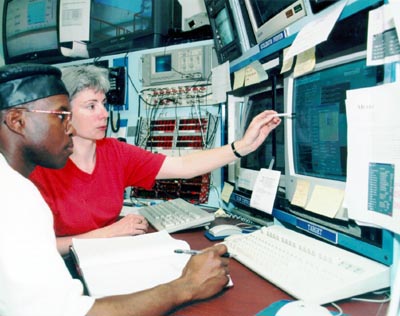 Allison Lung and Paul Gueye, Hampton University user, in the Hall C control room recently, reviewing data for another Hall C Experiment |
"It's a very, very tiny effect," Lung says. "You only see it when your electrons are polarized and you look closely at the differences in the number of events your detectors count for each electron helicity. You need, and with this equipment we expect to get, huge numbers of events to get a statistically significant sample. JLab is the perfect place to do this type of experiment because of the high quality of its polarized beam."
By spring 2000, technicians will begin to assemble the entire apparatus in Hall C. By June 2001 all G0 components are expected to be in place. Commissioning runs will commence shortly thereafter. Data will be taken two to three months a year for five years.
"This isn't something we're going to put up and take down," Lung points out. "We're going to keep it in Hall C. Meantime, we'll be working on future experimental uses for the equipment. We hope the G0 experiment and equipment will have a long and fruitful life."
Into the machine
Welding crucial to Lab's smooth superconducting operation
by James Schultz
Travelers crossing unfamiliar or exotic terrain are often advised to stick together. At Jefferson Lab, where explorers chart the frontiers of nuclear particle physics, similar counsel applies. Though at JLab, it's the welding that literally holds things in one piece.
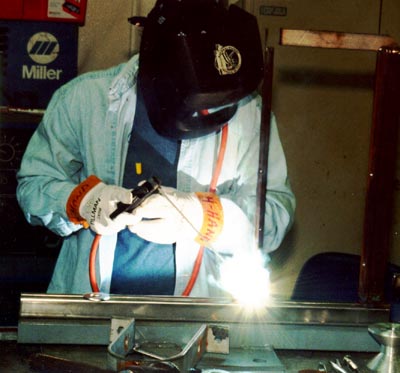 Danny Forehand stick-welds a bracket. |
While not all of the Lab's 14-member corps of welders work in cryogenics, all are well aware that welding is crucial to the smooth operation of JLab superconducting technology. Even the smallest seepage could allow ambient air to infiltrate and contaminate the system, which would shut down cryogenic cooling. Experiments would thus be impossible to complete.
"When we say something leaks, we're talking molecules of helium," says Brian Murphy, a senior mechanical technologist and a certified welding inspector. "Even that can be enough to contaminate the system. Anything threaded will leak. The safest way to make everything leak-proof is to weld. Once [fittings or pipe sections are] welded and leak-tested to our stringent standards, leakage is not much of a problem."
Even though welding may convey longevity and strength, a welder's job at JLab is never done. To guarantee a leaktight system, an estimated 10,000-plus welds have been completed on the components and subcomponents comprising the Lab's cryogenics network. System improvements, increased capacity, upgrades, even work requested by other laboratories ends up on the welders' to-do lists, ensuring there's little down time.
"There's plenty to do and the work is not always simple," says Cryogenics Deputy Bill Chronis. "We have multiple pipe systems, for instance, and inner lines within one main line. In summer the sun can heat the surface of that outer pipe, but we have to keep the inside pipes at about two degrees Kelvin (minus 426 degrees Fahrenheit)."
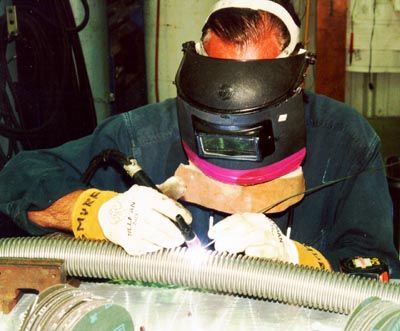 Brian Murphy mends a hole in stainless steel piping. |
Of the three welding materials commonly used at the Lab " aluminum, copper and stainless steel " stainless steel is preferred because it expands or contracts the least over the operating-temperature range. Although Lab engineers typically take such variations into account " designing and building anchors, supports and contraction joints that allow the colder interior pipes to contract without over stressing those inner lines " one 380-foot section of helium-supply pipe can contract more than a foot as the line is cooled to operating temperature.
Before being allowed to weld in the Lab's Cryogenic Group, welders must master a three-level certification process, which includes welding tests and X-ray examination of their work's integrity and strength. Any welder's goal is to keep joined materials as strong, or stronger than the sum of the individual parts. Therefore, as they connect pipe or other structures, welders must take pains to ensure that the molecular structure of both parent and daughter materials don't substantially change when heat is applied.
"We try to keep it simple," Murphy says. "Ninety percent of our welding is gas/tungsten-arc welding. Maybe 10 percent of the time we use silver solder or hand brazing. We do use stick welding, but that's for a stair or a railing."
The Lab thus far has recorded no weld-related mishaps or equipment breakdown related to faulty welds. Chronis says that's no guarantee that something can't go wrong. But JLab's twin emphases on excellence and expertise so far appears to have forestalled any serious difficulty.
"Our welders are good," Chronis contends. "Our cryogenics availability confirms it."
Training: New self-study resources offer staff scheduling flexibility, information
To better meet the staff development and training needs of Lab employees, the Human Resources Department recently made a variety of programs available in the new self-study area of the Library.
Four individual computer stations and two VCR carrels have been installed at the far end of the Library. Training programs available on CD-ROM (and soon Web-based training) are accessible from the computer stations, while training videos may be viewed from the VCR carrels.
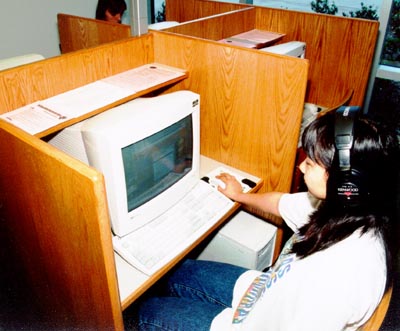 Jia Fan, Old Dominion University student and JLab Library intern, reviews one of the instructional programs Staff Development and Training has available on CD-ROM. |
Most of the courses and programs currently available are on the Library shelves adjacent to the self-study area. A few "reserved" items are available at the front desk. The JLab Curriculum Catalog lists the programs and courses that may be taken through self-study. Many of the courses are linked to broad Lab employee competencies or desired skills.
"We recognize that there are more ways to get training than sitting in a class," said Bruce Ullman, Staff Development and Training manager. "We want to offer a program that is flexible--providing training options from formal classes to self-paced study. If you need to take a class but just can't get to it, this is the way to go," he added.
He foresees fewer formal classes in the future and more training on demand and self-paced instruction. Training on demand is not self-study -- it involves a supervisor, working group, or team identifying their training objectives and having HR tailor a specific training program to meet their needs. The group/individuals decide when and where they will receive the training.
 Ana Lima, George Washington University and Hall B user, checks out a training video in one of the new video carrels located in the Library. |
The Training and Development office has about 40 self-study or training on demand programs including management & supervisory skills, teamwork, public speaking, Quality Management, business grammar, data base design, how to use Windows, and improving communication skills. The course listing will continue growing. New offerings will be available in the Fall Curriculum Catalog due out toward the end of the summer.
Lab welcomes new Employee Relations Manager
There's a new face amidst the bustle of daily activities at Jefferson Lab: Pat Morton, Employee Relations manager.
 |
Morton joined the Lab's Human Resources staff April 28. Her responsibilities include all employee relations and staff performance management functions.
She describes herself as being a sounding board for Lab staff and management employees. "I'm here for both sides. I'm here to listen to issues and provide unbiased input and guidance on employee performance, employee development, and policy issues," she explained. "I see myself as a resource for managers. There are so many highly skilled, bright people at the Lab, HR is here to help them deal with day-to-day concerns and issues so they can focus on the science being done here."
Morton's goals include developing and implementing the Lab's 360-degree feedback program, and working with management to integrate the feedback program with the competency development program. She will also oversee moving the Administrative Manual onto the Lab's Web site.
She hopes to further bolster the Employee Assistance Program through regular presentations in high-interest areas. Morton also wants to enhance the Lab's awards and recognition program beyond service awards to include retirement recognition and other noteworthy achievements.
Upon joining the Lab staff, Morton set for herself the goal of meeting everyone here within three months. "If your department, group, section, or shift is holding a meeting -- swing shift, owl, anytime -- let me know, and I'll be there," she said. "I've been all over the Lab, but I haven't met everyone, yet. I want people to recognize me and know I'm here to help in any way I can."
Morton can be reached by e-mailing her at pmorton@jlab.org, dialing ext. 7232, or dropping by her office, room 44 of the VARC.
She is an alumnus of the College of William and Mary and brings more than 20 years of consulting and Human Resources management experience to her new job. Morton has extensive experience in employee relations, employee development, and a special interest in effectiveness measurement techniques for these functions.
Smith retires after decade of service with Lab
On April 30, Gladys Smith bid Jefferson Lab adieu. Her retirement comes after working at the Lab since 1988.
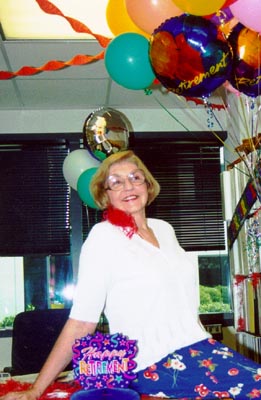 |
She was initially hired to support the Lab's scientific director, Dr. Dirk Walecka, and was instrumental in supporting the scientific director's efforts and goals toward making the Continuous Electron Beam Accelerator Facility a reality.
In 1992, her skills and talents were redirected to provide support to the growing JLab User Community. As departmental secretary for User Liaison, Smith helped develop procedures and provided support for the Program Advisory Committee, the Jefferson Lab Users Group, the Users Group Board of Directors, the Nuclear Physics Experiment Scheduling Committee, the Energy Sciences Network, and many on- and off-site conferences and workshops. She was an indispensable resource to both the User Liaison staff and Lab users.
Gladys was honored during a surprise party on April 30.
Mark your calendar for Lab Luau, July 23
The Jefferson Lab Activities Group is planning a new family event later this summer.
"We're working out the details," says Dave Williams, JAG chair. "We want to host a Lab Luau on Friday, July 23. We'll have food, drink and games." He said the event will probably start around 4 p.m. and be held adjacent to the Residence Facility. The event will be open and free to all Lab staff, their family members and users.
"We hope to have a great turn out for the event. Watch the JAG bulletin boards and the Lab news web page for more information," Williams said.
New Lab posters available for pickup
The Public Affairs office has extra copies available of the latest Jefferson Lab poster. The new lithograph features a unique image of the interior of the Hall B CEBAF Large Acceptance Spectrometer (CLAS). It also includes smaller photos of the CEBAF Linac; Experimental Halls A, B and C; the Free Electron Laser and the Applied Research Center.
The posters are on top of the file cabinet next to the Director's Office color copy machine and adjacent to Room B206, CEBAF Center. The poster is great for office decoration or presenting to special visitors and Lab staff.
Sign up now to help with Open House
The Lab Open House planning committee still needs people to help with Open House activities and exhibits on Saturday, June 26.
"We need people to help at the bus stops and the refreshment stands; as well as with the EEL, FEL, experimental halls and accelerator tours; crowd control; and the hands-on activities," says Sarah Ingels, special event coordinator.
Lab staff, users and their spouses and family members (age 10 or older) wishing to help may contact Volunteer Coordinator Julie Oyer; phone 269-7120 or e-mail oyer@jlab.org to sign up or for more information. Openings are available for morning, afternoon and all-day shifts.
Public Affairs wants your story ideas
Public Affairs is looking for newsletter story ideas. If you have a story idea, or if you are doing something interesting or unique this summer, let Linda Ware or Debbie Magaldi know.
Drop them an e-mail at ware@jlab.org or magaldi@jlab.org with your input.
 |
Ruben Pedroza, Human Resources, places the new 15 Year Service Awards in the VARC Lobby display case. This year marks the first time that the Lab will recognize staff with 15 years of service. The 1999 Service Awards Ceremony is set for November 16.
In appreciation for long-time service, 15 year recipients will be able to select a gift from the Service Awards catalog. The choice of gifts for 15 year recipients includes a men's or women's watch, a crystal water pitcher, a coaster desk set with leather inlay, and a black leather portfolio. Each gift is inscribed with the Jefferson Lab logo.
All 5, 10 and 15 year gift selections may be viewed in the Service Awards display cases located in CEBAF Center and in the VARC.
Secretary of Energy Bill Richardson recently unveiled a sweeping reform of Dept. of Energy security programs.
A key component of Richardson's plan is a comprehensive security reorganization at the DOE and its national laboratories. The plan calls for the creation of a new office, the Office of Security and Emergency Operations. It will be responsible for all safeguards and security policy, cyber-security, and emergency operations functions throughout the DOE. It will also oversee all security-related functions which previously were handled by different DOE program offices.
Richardson's initiative is aimed at correcting long-standing bureaucratic problems and resource deficiencies and brings more accountability to DOE's security programs, according to an official statement from his office.
"This security reform plan gives DOE the tools and authority we need to detect security infractions, correct institutional problems and protect America's nuclear secrets," said Secretary Richardson. "Coupled with previous counterintelligence and security measures we have already implemented, we are bringing more responsibility and accountability and a higher level of attention to these important matters."
Secretary Richardson said, "This new office will report directly to me and will strengthen and consolidate the management of our various security programs and will ensure the proper implementation of the many new counterintelligence and security measures I have ordered." Impacts to JLab are being discussed internally and will be reported.
Editor's note: If you have or know of a web site that could be informative or useful to Jefferson Lab staff, call the public affairs office at ext. 7689 or e-mail Linda Ware (ware@jlab.org).
Check out the Department of Energy's many accomplishments at www.doe.gov/accomplishments/. This site is a compilation of reports about the significant economic impact DOE's Research & Development program has had on this country. The site also tells how DOE R&D has improved people's lives and its remarkable advances in science. The site was developed by DOE's Office of Scientific and Technical Information, and is fully-searchable and includes both full text and bibliographic citations of reports of accomplishments.
contributed by Ron Sundelin

